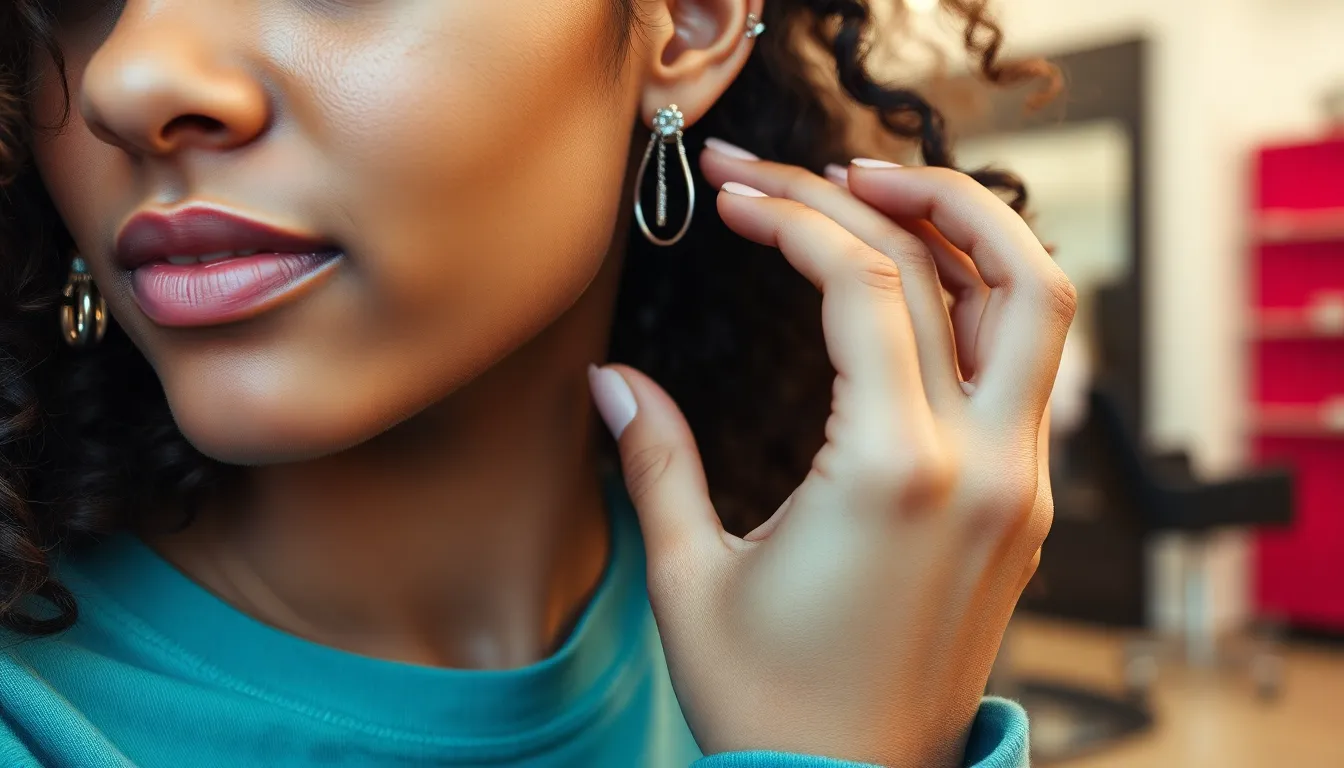Ear piercings are a popular form of self-expression, but for some, they can lead to unwanted complications like keloids. These raised scars form when the body overproduces collagen during the healing process, often resulting in painful and unsightly growths. Understanding how to prevent keloids is essential for anyone looking to enjoy their piercings without the worry of scarring.
With a few proactive steps, individuals can significantly reduce their risk of developing keloids. From choosing the right type of jewelry to following proper aftercare techniques, the journey to beautiful piercings doesn’t have to come with the fear of keloid formation. This article explores effective strategies to keep those ear piercings looking great while minimizing the chances of keloids.
Table of Contents
ToggleUnderstanding Keloids
Keloids represent raised scars resulting from excessive collagen buildup during the healing process. Comprehending what keloids are and their causes aids in effectively preventing them.
What Are Keloids?
Keloids are fibrous growths that extend beyond the original injury site. Keloids often appear firm and rubbery, with a smooth texture and can vary in color from skin tone to darker shades. Keloids can develop anywhere on the body, particularly in areas prone to skin tensions, such as the ears. They may also cause discomfort or itching, making early intervention essential.
Causes of Keloid Formation
Keloid formation stems from several factors, including:
- Genetics: Genetic predisposition significantly influences keloid development. Individuals with a family history of keloids are at a higher risk.
- Skin Type: Certain skin types, especially darker or more pigmented skin, show a greater likelihood of keloid formation after injuries.
- Severity of Injury: The extent of the initial injury plays a crucial role. More severe injuries, such as deep cuts or piercings, increase the chances of keloid formation.
- Age: Younger individuals, particularly those between 10 and 30 years old, often experience higher rates of keloid development.
- Hormonal Changes: Hormonal fluctuations can trigger keloid growth, making pregnancy or other hormonal shifts potential risk factors.
Understanding these causes clarifies the need for preventive measures during the ear piercing process.
Risk Factors for Keloids

Understanding the risk factors for keloids helps individuals make informed decisions before getting ear piercings. Several factors contribute to the likelihood of keloid formation, including genetic predisposition and skin type.
Genetic Predisposition
Genetic predisposition plays a significant role in keloid development. Individuals with a family history of keloids face a higher risk of developing them themselves. Studies indicate that people of African, Asian, and Hispanic descent exhibit a greater tendency for keloid formation compared to individuals of European descent. Genetic markers associated with connective tissue disorders can intensify the body’s response to skin injuries, further increasing the likelihood of keloid scars.
Skin Type and Sensitivity
Skin type and sensitivity also influence susceptibility to keloids. Sensitive skin may react more aggressively to trauma, leading to excessive collagen production during the healing process. Individuals with oily skin or conditions like acne may find their risk for keloids heightened due to inflammation and the formation of scars. Identifying and understanding one’s skin type helps in selecting appropriate aftercare products, which can minimize the chances of keloid formation following ear piercings.
Best Practices for Preventing Keloids on Ear Piercings
Preventing keloids on ear piercings involves careful consideration of methods and professional practices. Adopting effective strategies reduces the risk of keloid formation during the piercing process.
Choosing the Right Piercing Method
Selecting the appropriate piercing method greatly influences keloid risk. Consider these factors:
- Piercing Gun vs. Needle: Piercing needles create a cleaner hole with minimal tissue damage compared to piercing guns, which can cause more trauma and increase keloid risk.
- Single-Use Needles: Opt for single-use, sterile needles to ensure hygiene and reduce infection rates, a potential trigger for keloids.
- Location Matters: Choose a site on the ear with less tension on the piercing. Areas with constant movement, like the cartilage, may be more prone to complications.
Importance of Professional Piercing
Professional piercing significantly lowers the likelihood of keloids. Key points to consider include:
- Experienced Practitioners: Licensed professionals possess the expertise to position and puncture accurately, minimizing damage and inflammation.
- Clean Environment: Professionals operate in sterile conditions, reducing infection risks and ensuring proper aftercare guidance.
- Jewelry Selection: Experts can recommend suitable jewelry materials to select hypoallergenic options, such as titanium, to prevent allergic reactions that may lead to keloids.
Implementing these best practices fosters a safer piercing experience while minimizing keloid formation risk.
Aftercare Tips
Proper aftercare significantly reduces the risk of keloid formation after ear piercings. Following a consistent routine for cleaning and monitoring the piercing is essential.
Cleaning and Maintenance
Cleaning the piercing site daily with saline solution or a mild non-alcoholic antiseptic prevents infection and promotes healing.
- Saline solution: Use a pre-mixed saline solution or make one by dissolving 1/4 teaspoon of non-iodized sea salt in 1 cup of warm distilled water.
- Clean hands: Always wash hands before touching the piercing or changing jewelry.
- Gentle care: Use a clean cotton ball or swab to apply the saline solution. Avoid using cotton swabs directly in the piercing.
- Avoid harsh products: Do not use alcohol, hydrogen peroxide, or heavy ointments, as these can irritate the skin and hinder healing.
- Jewelry checks: Verify that jewelry fits properly and isn’t too tight to prevent excess pressure on the piercing.
Signs of Infection to Watch For
Monitoring for signs of infection helps ensure timely treatment if it occurs.
- Redness: Persistent redness around the piercing can indicate inflammation or infection.
- Swelling: Noticeable swelling that worsens instead of diminishing post-piercing may signal an issue.
- Pain: Intense or increasing pain, especially after the first few days, warrants attention.
- Discharge: Pus or thick discharge, particularly if yellow or green, suggests infection.
- Fever: Any accompanying fever requires immediate consultation with a healthcare provider.
By adhering to these aftercare tips, individuals can maintain healthy piercings and minimize the chance of developing keloids.
Home Remedies and Treatments
Home remedies and treatments can effectively aid in preventing keloids on ear piercings. These methods focus on natural ingredients and practices that promote healing and reduce the risk of excessive scar tissue formation.
Natural Solutions
- Aloe Vera: Aloe vera contains anti-inflammatory properties. Applying aloe vera gel to the piercing site may soothe irritation and support healing.
- Honey: Honey acts as a natural moisturizer and has antibacterial properties. It can be applied directly to the area to keep it hydrated and help prevent infections.
- Tea Tree Oil: Tea tree oil is known for its antiseptic qualities. Diluting a few drops in a carrier oil and applying it to the piercing may help reduce inflammation.
- Vitamin E Oil: Vitamin E oil can promote skin regeneration. Rubbing vitamin E oil gently around the piercing may enhance healing and reduce scar formation.
- Lemon Juice: Lemon juice provides natural astringent properties. Diluting it and applying it around the piercing can help keep the area clean, but it should not be used if the skin is broken or irritated.
When to Seek Medical Advice
- Seek medical advice if a piercing shows persistent signs of infection. Symptoms include consistent redness, swelling, and pain.
- Consult a healthcare provider if there is discharge from the piercing that appears mucous or has an unusual odor.
- Consider visiting a professional if keloid symptoms arise, such as the stretched appearance of skin or unusual growth near the piercing site.
- Schedule an appointment if experiencing fever or other systemic symptoms that may suggest a severe infection. Timely intervention can prevent complications and support effective healing.
Preventing keloids on ear piercings requires a proactive approach and careful attention to detail. By choosing the right jewelry and following proper aftercare techniques, individuals can significantly reduce their risk. Understanding personal risk factors and utilizing recommended home remedies can further enhance the healing process.
It’s essential to remain vigilant for any signs of infection or abnormal growths and seek medical advice when necessary. With the right knowledge and practices in place, anyone can enjoy their ear piercings while minimizing the chances of keloid formation. A little effort goes a long way in ensuring a safe and satisfying piercing experience.









